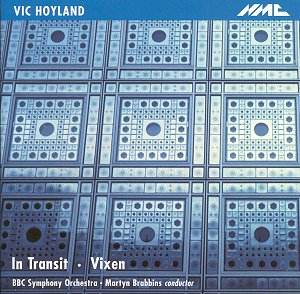Since the early 1970s Vic Hoyland has slowly been producing
a catalogue of works that are as striking in their originality and substance
as anything written by a British composer of the 1940s' generation.
In some ways he has done this quietly, perhaps without the public profile
of certain of his contemporaries. He is also not overly prolific by
some standards but gives the impression of a fastidious craftsman, a
characteristic that he carries over into his other persona as an influential
teacher, having been resident at Birmingham University since the early
1980s.
It was some years before Hoyland turned to orchestral
music, with most of his early works employing voices in some shape or
form including EM of 1971 for twenty-four voices, ES (1971)
for instrumental ensemble and voices and Jeux-Thème of
1972 for mezzo-soprano and chamber ensemble. There are also a number
of music-theatre works that demonstrate the composerís strong interest
and reputation in this field, having been co-director of the ensemble
Northern Music Theatre along with fellow composer David Sawer. The mid-1980s
onwards however saw Hoyland veer towards instrumental music as a means
of demonstrating a greater interest in an abstract musical language
of which the two works recorded here, together with the Chamber Concerto
of 1993 are notable examples.
What impresses immediately in both of these works is
the clarity of Hoylandís compositional thought. Although the language
is in many ways uncompromisingly tough, there is an audible architectural
structure evident in both Vixen and In Transit that surfaces
through a strong sense of melody combined with the use of binding rhythmic
structures that although often complex, return regularly as points of
reference. As James Wishart points out in his note on In Transit,
the kind of melody Hoyland favours, although angular and highly chromatic
in nature, is "neither overtly tonal nor clearly atonal" meaning
that the listener will often be able to readily latch onto a melodic
fragment as it surfaces through the background detail of the music.
It can be no coincidence that one of Hoylandís early interests was architecture.
Indeed, it was the intricate patterns in the architecture of the Centre
for the Arab World in Paris that proved to be one of the major influences
in the composition of Vixen. This, Hoyland combines with an interest
in the mathematical writings of Avicenna, an eleventh century Persian
scholar whose work included reference to music but more specifically
to rhythm and rhythmic cycles. Finally, Vixen acknowledges a
link to Hoylandís earlier work for ensemble, Fox, written in
1983, and further develops some of the processes first used in that
work. Written in response to a BBC commission for the 1997 Cheltenham
Festival, Vixen is a major score in every sense of the word,
cast in five movements and spanning thirty-five minutes. Contemporary
works on this kind of scale can often present problems, yet there are
few recent major British scores that have impressed me as much as Vixen
in their sense of cogency. It is not just Hoylandís use of melody
that creates this cogency, but a whole range of gestural motifs, huge
brass chords often reminiscent of Messiaen, explosive outbursts of flutter
tonguing and a powerful feeling of inner drama, perhaps stemming from
the composerís interest in the theatrical elements of music. There are
also passages of luminous beauty in which Hoyland will magically float
a melody through the textures, the slow fourth movement being a fine
example, hauntingly memorable in its subtly colour washed orchestration.
In this respect the closing paragraphs of the work, inspired by late
afternoon bells tolling across Lake Como and the surrounding mountains
and captured by harps and percussion over a peaceful string chord, are
wonderfully evocative.
The origins of In Transit lay in a proposed
percussion concerto that failed to materialise. Hoylandís original conception
of using five percussionists deployed antiphonally to left, right and
centre remained, whilst also utilising two orchestras placed to either
side with one centrally placed percussionist whose function is to "focus"
the spatially orientated material of the orchestras and other percussionists.
In this way the material can often be "in transit" between
the two orchestras. On another level Hoyland cites a play on words where
the mechanistic nature of much of the material can be seen to represent
intransigence, "where obsessive reiterations and figurations occupy
the foreground". The spatial element of the work is captured supremely
well in this recording but it is the awesome cumulative power Hoyland
generates that keeps one truly riveted. As in Vixen, there are
moments of calm serenity, in particular three clear "points of
repose" marked by solos for a pair of flutes, solo flute and cor
anglais respectively, each over string chords, that once again serve
as points of reference in the structural framework. As in Vixen
melody plays a major part and it is the ever-recurring melody that lies
at the core of the piece that ultimately drives it to a powerfully charged
conclusion.
The BBC Symphony Orchestra are without question masters
of this repertoire and together with a conductor as tuned into the music
as Martyn Brabbins, combine to create a formidable force. The resulting
performances demonstrate both authority and virtuosity in abundance.
A word also for the booklet notes by Roger Marsh and James Wishart,
both of whom contribute invaluable biographical and musicological essays
on the composer and his music which I would strongly recommend reading
before listening. This is music that deserves to be represented on disc
and credit is once again due to Colin Matthews and NMC for bringing
it to life.
Christopher Thomas


